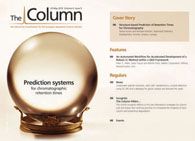Structure-based Prediction of Retention Times for Chromatography
Prediction systems for chromatographic retention times.
Chromatographic method development is a significant challenge in analytical chemistry. The chromatographer is asked to find an appropriate compromise between the often conflicting goals of resolution, robustness and run time. The problem of method development is typically divided into two stages. The first stage is the determination of the basic system on which development will proceed (type of chromatography, column choice etc.). The second stage is the optimization of continuous parameters (especially gradient and temperature) within that method space.
Traditionally, the first selection stage is based on a combination of the experience of the method development chromatographer and a limited number of screening experiments. The second stage is usually based on systematic optimization, commonly with software modelling. Software tools for optimization of separations have matured to the point where their use has become commonplace. More recently, software has also begun to be applied to the first stage of method development enabling chromatographers to select more suitable systems for optimization based on characteristics of the compounds of interest rather than by trial-and-error. However, there are many cases where systematic screening is impractical, especially when a method is not intended to become an organizational asset but rather will only be applied a few times. In these cases, the objective is usually to find an adequate method as fast as possible. When some or all of the chemical structures in the mixture are known with a high degree of confidence, it is feasible to perform selection between several “generic” methods based on chemical structures. This article will describe a new system for fast, effective selection between generic methods based on retention time prediction.
Best of the Week: Food Analysis, Chemical Migration in Plastic Bottles, STEM Researcher of the Year
December 20th 2024Top articles published this week include the launch of our “From Lab to Table” content series, a Q&A interview about using liquid chromatography–high-resolution mass spectrometry (LC–HRMS) to assess chemical hazards in plastic bottles, and a piece recognizing Brett Paull for being named Tasmanian STEM Researcher of the Year.
Using LC-MS/MS to Measure Testosterone in Dried Blood Spots
December 19th 2024Testosterone measurements are typically performed using serum or plasma, but this presents several logistical challenges, especially for sample collection, storage, and transport. In a recently published article, Yehudah Gruenstein of the University of Miami explored key insights gained from dried blood spot assay validation for testosterone measurement.
Determination of Pharmaceuticals by Capillary HPLC-MS/MS (Dec 2024)
December 19th 2024This application note demonstrates the use of a compact portable capillary liquid chromatograph, the Axcend Focus LC, coupled to an Agilent Ultivo triple quadrupole mass spectrometer for quantitative analysis of pharmaceutical drugs in model aqueous samples.

